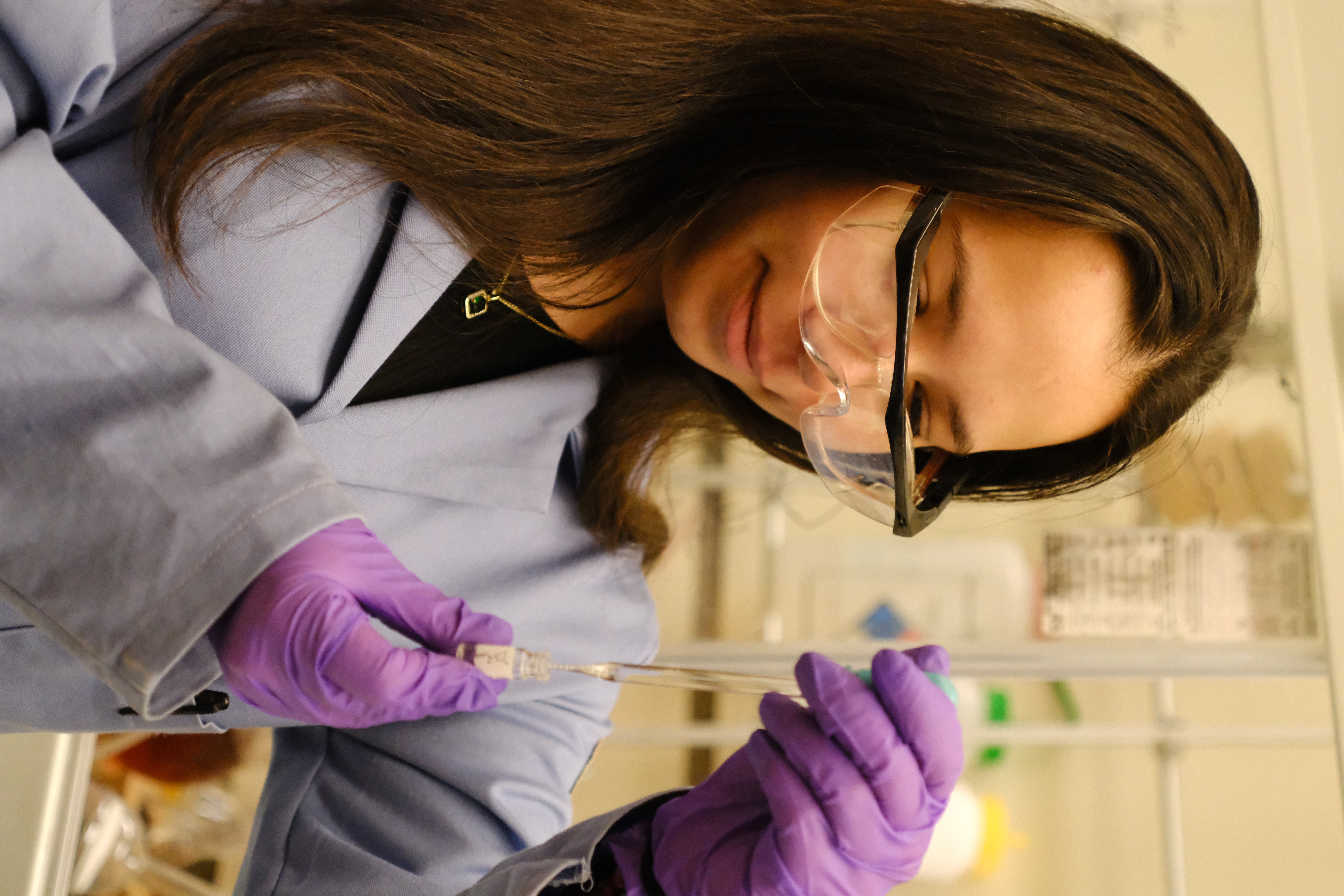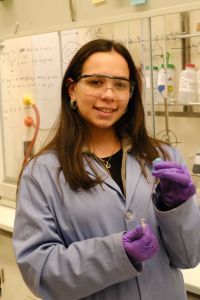Geraldine O’Hallorans Joins Global Effort to Fight Deadly Childhood Brain Cancer

The goal of Geraldine O'Hallorans' research is to develop better drug candidates by targeting a protein called ALK2, which belongs to a family of proteins known as kinases that help cells communicate by transferring phosphate groups from one protein to another—a bit like passing signals along a relay.
October 24, 2025 I By Dave DeFusco
When UNC chemistry major Geraldine O’Hallorans talks about her research, she does so with a mix of determination and empathy. Her project carried out under the guidance of Dr. David Drewry, a professor and principal scientist in the UNC Eshelman School of Pharmacy, focuses on finding potential drug treatments for a devastating childhood brain cancer called Diffuse Intrinsic Pontine Glioma, or DIPG.
DIPG mainly affects children between the ages of 5 and 7. It grows deep inside the brain stem, making surgery impossible. Current treatments, such as radiation, may extend a child’s life by a few months, but the disease remains almost universally fatal within a year of diagnosis.
“It’s absolutely horrendous,” said O’Hallorans. “There’s really nothing out there right now that can stop it.”

The goal of her research is to develop better drug candidates by targeting a protein called ALK2, which belongs to a family of proteins known as kinases that help cells communicate by transferring phosphate groups from one protein to another—a bit like passing signals along a relay. In DIPG tumors, ALK2 becomes overactive and contributes to uncontrolled cell growth. Blocking its activity could slow or even stop the cancer’s progression.
To do that, O’Hallorans and her team are building on a compound called M4K2009, discovered by using an open science approach as a promising ALK2 inhibitor. “M4K2009 showed strong potential in blocking ALK2,” she said, “but when you target one kinase, you have to make sure you’re not accidentally affecting others. We’re working to design compounds that are highly selective so they attack the target of interest and decrease other protein liabilities. This should enable us to only target the tumor without harming healthy cells.”
Designing such compounds is where chemistry plays a starring role. O’Hallorans uses a key compound, called an aldehyde intermediate, as a flexible starting point. “Aldehydes are really versatile,” she said. “They can react in different ways to form molecules of various shapes and sizes. That’s important, because even tiny changes in structure can affect how well a compound fits into the target protein.”
This versatility lets researchers create a wide variety of related compounds, called analogues, and test which ones have the best combination of properties: potency, or how strongly they inhibit ALK2; solubility, or how easily they dissolve in water or fat; and brain penetration, or how well they can cross the brain’s protective barrier. That last factor is particularly challenging. The brain’s blood-brain barrier blocks most substances from entering, protecting it from toxins but also keeping out many potential drugs.
“We have to design molecules that have the right properties to get through the blood-brain barrier,” said O’Hallorans. “That’s one of the hardest parts.”
This is another reason she uses an aldehyde intermediate in her research. Starting with this molecule allows her to create many different versions of the compound, which can help it bind more effectively to ALK2 and improve the key properties needed to cross the brain’s protective barrier.

The new compounds will be tested for binding to ALK2 in our UNC lab. The lab also collaborates closely with scientists around the world who will evaluate the compounds in other tests to help determine their potential as drug candidates. “We make the compounds here and send them to partners,” she said. “We then use their biological results to help us design better, more effective versions of the compounds.”
That spirit of teamwork extends beyond their lab partners. O’Hallorans’ project is part of an open science initiative, meaning all data, results and compound designs are shared freely with the global scientific community.
“The reason we do open science is because DIPG is rare and affects children,” she said. “We don’t want the cost of developing a treatment to make it unaffordable. By sharing everything, we can help more researchers build on what we’ve done.”
The Drewry lab is a part of the Structural Genomics Consortium, which was established in 2015, across multiple universities throughout the world. With funding from both industrial and government sources, the SGC is committed to open science to unlock underexplored areas of the human genome for therapeutic breakthroughs.
“Our UNC research team is grateful for funding from The Cure Starts Now that allows us to address this important challenge,” said Professor Drewry. “We extend a heartfelt thank you to these organizations and the families that they represent.”
In addition to The Cure Starts Now, the following organizations have contributed to the effort: Brooke Healey Foundation; Melina Michelle Edenfield Foundation; The Cure Starts Now Australia; The Cure Starts Now Canada; Reflections Of Grace Foundation; Yuvaan Tiwari Foundation; Cure Brain Cancer Foundation; Aubreigh’s Army Foundation 328; Aidan’s Avengers; Run DIPG; Musella Foundation; Love4Lucas Foundation; Whitley’s Wishes; Anna’s Bake Sale Foundation; The Ayla Foundation; The Isabella and Marcus Foundation; Love, Chloe Foundation; Lauren’s Fight for Cure; Robert Connor Dawes Foundation; Ryan’s Hope; The Gold Hope Project; Abby’s Corner Foundation; The DIPG/DMG Collaborative; and Snapgrant.com.
For O’Hallorans, the project is both scientific and deeply personal. “Healthcare in this country is already so expensive,” she said. “If what we’re doing can help make a life-saving drug affordable for families, that’s what matters most.”

